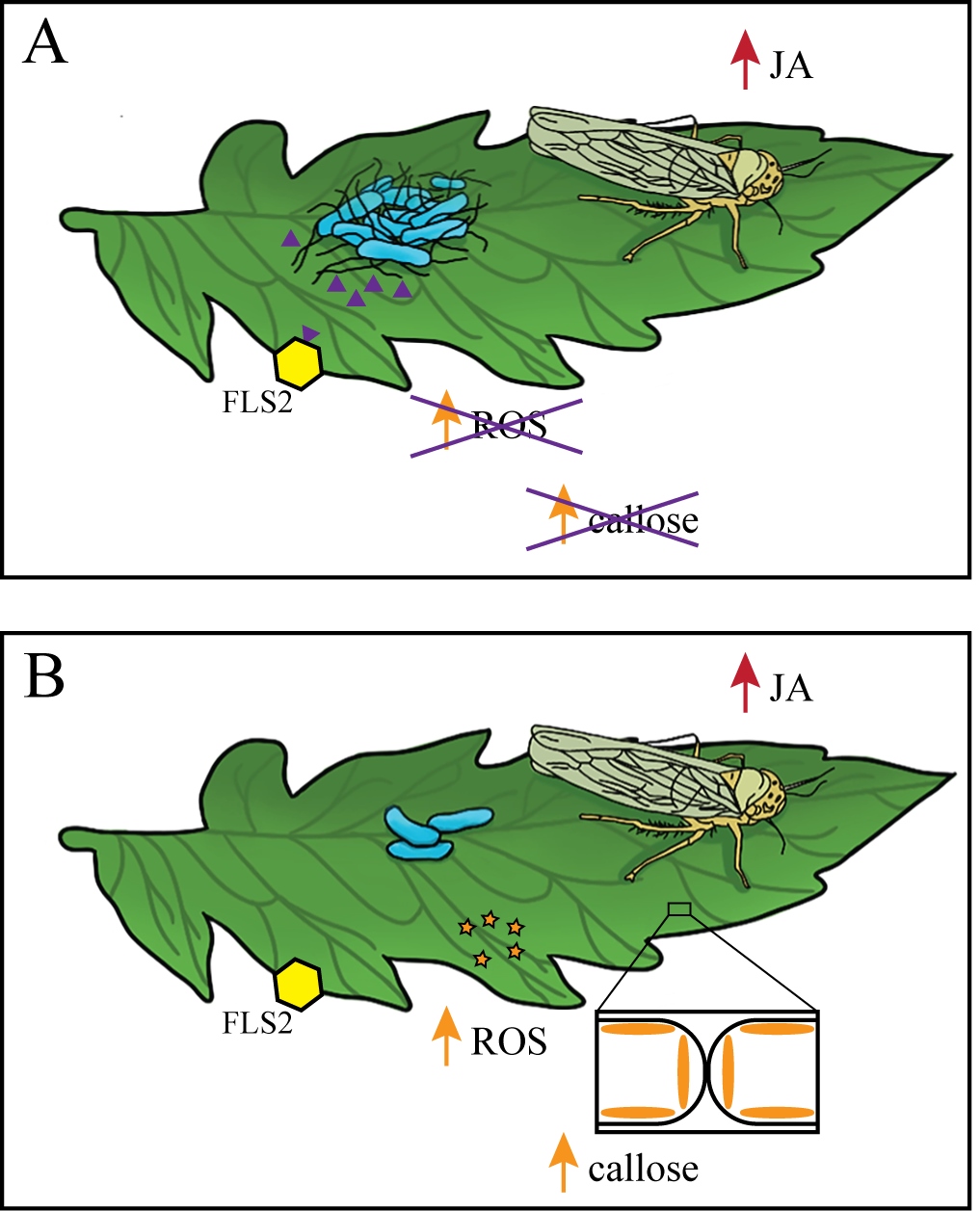Dr. Kim Cowles
 We have demonstrated that plants infected with bacterial pathogens harbor larger Salmonella enterica populations than healthy plants and in some cases S enterica populations increase on infected leaves. We hypothesize that S. enterica benefits from the bacterial plant pathogen’s manipulation of host defenses. Kim is using a tomato – Xanthomonas sp. patho-system to examine host gene expression during Xanthomonas-infection and S. enterica colonization, as well as host hormones. We expect to delineate the role of host immune modulation in S. enterica‘s success on infected plants.
We have demonstrated that plants infected with bacterial pathogens harbor larger Salmonella enterica populations than healthy plants and in some cases S enterica populations increase on infected leaves. We hypothesize that S. enterica benefits from the bacterial plant pathogen’s manipulation of host defenses. Kim is using a tomato – Xanthomonas sp. patho-system to examine host gene expression during Xanthomonas-infection and S. enterica colonization, as well as host hormones. We expect to delineate the role of host immune modulation in S. enterica‘s success on infected plants.
Previously, Kim focused on the role of the host in the tri-trophic interaction between bacterium – phytophagous insect – plant. The co-association of phytophagous insects, such as the Aster leafhopper, Macrosteles quadrilineatus, results in S. enterica populations that persist at higher levels for longer periods of time when compared to plants treated with S. enterica alone.
Below is her model describing the link between the bacterial flagellum and the positive effects of leafhopper infestation on S. enterica persistence. (A) Leafhopper infestation leads to increased populations of flagellated S. enterica (blue) on the leaf surface. Leafhopper-induction of the JA response (red) in combination with recognition of extracellular S. enterica flg22 peptides (purple triangles) by FLS2 (yellow hexagon) inhibit ROS activation and callose deposition. (B) Although leafhoppers induce the JA response (red), non-flagellated S. enterica populations (blue) decline due to activation of ROS activation (orange stars) and callose deposition(Cowles et al., 2018).

Education and Research Experience
Postdoctoral Fellow, Department of Molecular Biology, Princeton University, Princeton, NJ, 2006-2011 (NIAID Ruth L. Kirschstein National Research Service Award, 2008-2011)
Ph.D., Microbiology, University of Wisconsin-Madison, 2006
B.S., Microbiology, University of Illinois-Urbana-Champaign, 2000 (summa cum laude)
Abstracts
Cowles, K. and Barak, J. Manipulation of the plant immune response by Xanthomonas garderni leads to an increased persistence of Salmonella enterica on tomato plants. 2019 Molecular Genetics of Bacteria and Phages Meeting, University of WI-Madison, August 5-9
Publications
Megan H. Dixon, Kimberly N. Cowles, Sonia C. Zaacks, Isabel N. Marciniak, Jeri D. Barak. 2022. Xanthomonas infection transforms the apoplast into an accessible and habitable niche for Salmonella enterica. Appl. Environ. Microbiol. Link
Cowles, K.N, Groves, R.L., and Barak, J.D. 2018. Leafhopper-induced activation of the jasmonic acid response benefits Salmonella enterica in a flagellum-dependent manner. Front. Microbiol. doi: 10.3389/fmicb.2018.01987 Link
Cowles, KN, Willis, DK, Engle, TN, Jones, JB, and Barak, JD. 2016. Diguanylate cyclases, AdrA and STM1987, regulate Salmonella enterica exopolysaccharide production during plant colonization in an environment-dependent manner. Appl. Environ. Microbiol. 82(4): 1237-1248. Link
Merritt, JH, Ha, DG, Cowles, KN, Lu, W, Morales, DK, Rabinowitz, J, Gitai, Z, and O’Toole, GA. 2010 Specific control of Pseudomonas aeruginosa surface-associated behaviors by two c-di-GMP diguanylate cyclases. MBio. 19:1(4). Pii e00183-10. Link
Cowles, KN and Gitai, Z. 2010 Surface association and the MreB cytoskeleton regulate pilus production, localization and function in Pseudomonas aeruginosa. Mol Microbiol. 76(6):1411-26. Link
Herbert, EE, Cowles, KN, and Goodrich-Blair, H. 2007 CpxRA regulates mutualism and pathogenesis in Xenorhabdus nematophila. Appl Environ Microbiol. 73(24):7826-36. Link
Cowles KN, Cowles CE, Richards GR, Martens EC, Goodrich-Blair H. 2007 The global regulator Lrp contributes to mutualism, pathogenesis and phenotypic variation in the bacterium Xenorhabdus nematophila. Cell Microbiol. 9(5):1311-23. Link
Park Y, Herbert EE, Cowles CE, Cowles KN, Menard ML, Orchard SS, Goodrich-Blair H. 2007 Clonal variation in Xenorhabdus nematophila virulence and suppression of Manduca sexta immunity. Cell Microbiol. 9(3):645-56. Link
Cowles KN, Goodrich-Blair H. 2005 Expression and activity of a Xenorhabdus nematophila haemolysin required for full virulence towards Manduca sexta insects. Cell Microbiol. 7(2):209-19. Link
